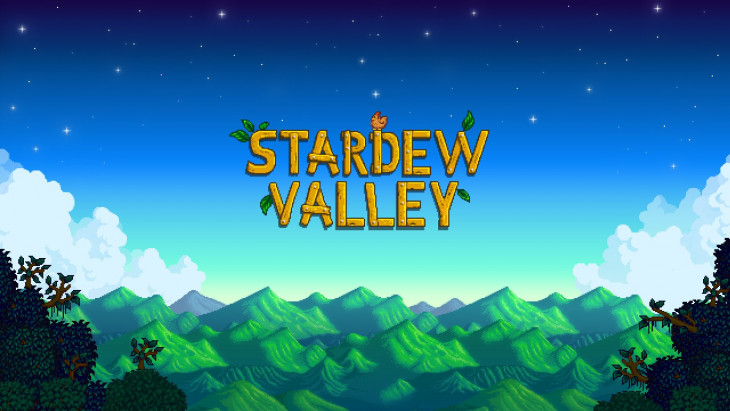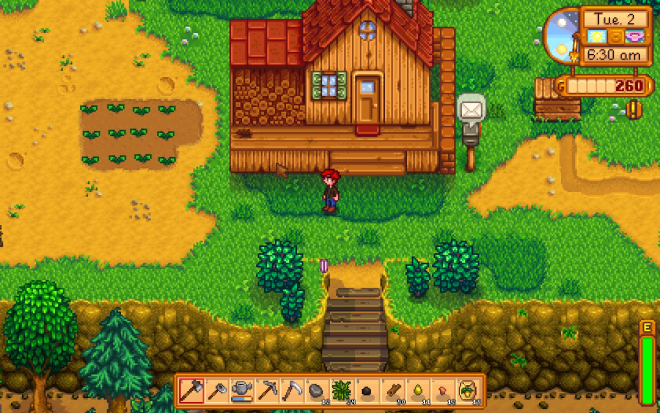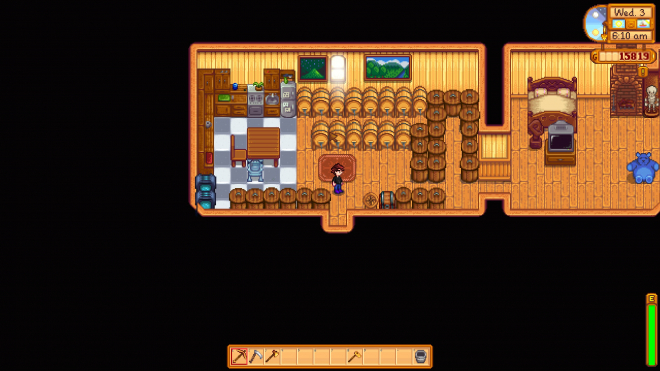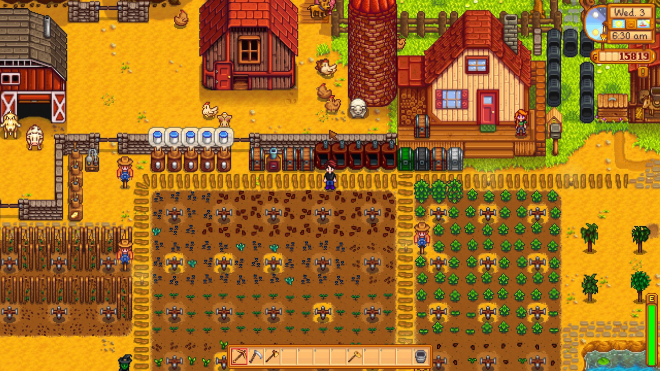
Recently I have noticed that farming simulators have been gaining in popularity. This game seemed to have gained popularity quite quickly once it was released. When the game was first released it was massively popular, with youtube being flooded with gameplay videos. Having watched some of these videos prior to playing the game I would have to say that watching this being played is an entirely different experience. This game can be as casual or as hardcore as the player wants to make it, with each experience being as unique as the player.

When the game begins, there is an optional cutscene that explains why the player has come to their new home: Stardew Valley. There are a few different farm types to select from, each having a specific strength and drawback. Each map has great aspects, which the player can use to be successful. The standard farm has a lot of open space in which to plant continuous crops, while the river farm has more rare fish show up more often while fishing on the farm. The farm always starts overgrown, and it is up to the player to decide exactly what they would like to do from there. With each of the farms I have seen, the exact play style is as individual as the player themselves.
As time passes the player will grow more crops, clear out their farm, fish, mine, or forage. Almost anything that the player does can have a monetary benefit. There is a drop box on the side of the house in which the player will drop anything they wish to sell. At the end of the day, after they sleep but before the new day, the player will be shown how much they made for the items placed in the box. This way you can make more money off of the items versus how much you would make by selling it to any of the many merchants in the valley. Beware though: only the last item put in the box is able to be taken out. If something is accidentally placed into the box, it may be easier to restart the day as it may be lost forever. The more you sell the more seeds or crops you can purchase, which in turn can make more money. Different crop seeds are available, with some taking 4 days to grow, while others can take 6, 18, or 15 days to grow. There are yet other seeds that could take an entire season to grow. The longer it takes to grow the more valuable the crops tend to be, but also the longer time it would be until you have the next paycheck to purchase something. This is one of the many time and resource management skills that this game will (hopefully) teach the player.
There are different parts of the map that can be explored. One that has been very valuable to me was the mine. The mine is where you can get the valuable ores, minerals, and precious stones. There are a finite number of levels, with special surprises at different levels. The deeper you go different ores show up, with stone and coal at the top. Copper, iron, and other ores show up the deeper you explore. This ore can be used to craft different items or to upgrade the house or the tools. Clint, the blacksmith, requires a certain amount of specific items in order to upgrade your tools. Upgraded tools will help clear items more quickly and with less energy used. That is something that you need to manage, because while Clint is upgrading the item it isn't in your inventory. Sometimes it may benefit you to pause the game to plan the next few days so that you can upgrade your axe, pick, hoe, or watering can. If you don't want to mine the ores, though, you can always buy them from Clint.

Something that I found enjoyable was the variation in crops and methods of income. While one player would focus very heavily on just the crops, another player could spend more time mining or fishing with the same financial result. I found that it was worth it to keep certain crops to make wines and jams. You can also spend time and resources on animals. There is a coop and a barn available. The coop makes chickens, ducks, and rabbits available, which each giving their own resource (eggs and fur). The barn makes cows, pigs, goats, and sheep available, providing their resources (milk, goat milk, truffles, and wool). Each of these items can benefit the player in different ways. Different crops can be mixed to make food, which in itself provides different levels of bonus's. I would very heavily suggest exploring different methods of making money so that you can find which one is most enjoyable to you.

One aspect of the game that took me by surprise was the friendship system. In Stardew Valley you can give gifts to, chat with, and do favors or jobs for each of the citizens of the town. Depending on the gift that you give each citizen it can have a positive, neutral, or negative effect on the relationship. As you talk to each of the citizens you can find out the likes and dislikes of the other citizens. The higher your friendship level you have with each citizen it allows for different cutscenes unique to the person. Many of the citizens are single, so marrying someone in the valley is an option if you so desire. I decided to start working toward marrying one of the citizens once my farm was mostly automated, so that I didn't have to worry about spending all day every day working on the farm.
Overall I love this game. I was hesitant to play it at first, but before I realized it I had been playing for hours in a single sitting. This game is easily one of the games I am ok with getting lost in. There are aspects of this game that I did not mention that make this game even more enjoyable, and I'm sure that there is even more that this game offers that could make it more enjoyable still. This game is one that I would see myself returning to, regardless of how long I have played it or how long it has been since I have played it last. If you are looking for a great game that is kid and family friendly. It can also help teach some valuable lessons on resource and time management, as well as the long term repercussions of everyday decisions.
I suggest this game very highly. It is definitely worth the cost.
AUTHOR INFORMATION

 Gameplay is as complicated or as simple as the player wishes. Want to automate the farm? Do it! What to explore the mines? Do so! This game allows the player to do as much or as little as they want.
Gameplay is as complicated or as simple as the player wishes. Want to automate the farm? Do it! What to explore the mines? Do so! This game allows the player to do as much or as little as they want.
 The controls are quite simple to master. The only issue is that it is easy to mis-click and to either give an unintentional gift, destroy a plant, or eat something. Having to restart a day so to not lose a plant or give a bad gift is a great way to waste time.
The controls are quite simple to master. The only issue is that it is easy to mis-click and to either give an unintentional gift, destroy a plant, or eat something. Having to restart a day so to not lose a plant or give a bad gift is a great way to waste time.
 The story is as complex as the player wants it to be. If the player wants to be a farmer and to ignore all else, it's easy to do so. If the player wants to socialize with the citizens of the valley, that is do-able as well. The story has very few parts that are required.
The story is as complex as the player wants it to be. If the player wants to be a farmer and to ignore all else, it's easy to do so. If the player wants to socialize with the citizens of the valley, that is do-able as well. The story has very few parts that are required.
 The 8 bit art style for this game was a wise decision. The game is simple, yet beautiful. This game is able to be a great game without requiring too much disk space.
The 8 bit art style for this game was a wise decision. The game is simple, yet beautiful. This game is able to be a great game without requiring too much disk space.
 The music for this game is beautiful. It also helps set the mood for cutscenes and sets the tone for each location. The music does change depending on location and season while not being obtrusive or irritating. It blended in with the game to the point it enhanced gameplay without drawing too much attention.
The music for this game is beautiful. It also helps set the mood for cutscenes and sets the tone for each location. The music does change depending on location and season while not being obtrusive or irritating. It blended in with the game to the point it enhanced gameplay without drawing too much attention.
PROS / CONS
- Classic Graphics
- Great Replay Value
- Upgrade System
- Relationship System
- Non-linear Gameplay
- Season and Weather Based Questing
- Time Management
- Luck Based
- Resource Management
- Grindy

